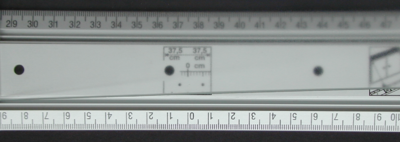- Distinctness of image
-
- See also
Distinctness of image, DOI, is a quantification of the deviation of the direction of light propagation from the regular direction by scattering during transmission or reflection. DOI is sensitive to even subtle scattering effects; the more light is being scattered out of the regular direction the more the initially sharp (well defined) image is blurred (that is, small image details are being lost). In polluted air it is the sum of all particles of various dimensions (dust, aerosols, vapor, etc.) that induces haze.
DOI is measured to characterize the visual appearance of polished high-gloss surfaces such as automotive car finishes, mirrors, beyond the capabilities of gloss.
Distinctness of Image and Blur The blur induced by a scattering layer (here: frosted glass) increases with the distance between the information (ruler scaling) and the scattering layer. The scattering layer is close to the ruler surface on the left side and the distance increases to the right as does the blur. The distinctness of image decreases with increasing blur. Other appearance phenomena are: gloss, haze, and orange peel
References
- ASTM Standards on Color & Appearance Measurement
- Richard S. Hunter, The Measurement of Appearance, John Wiley & Sons (1987).
External links
Instrumentation for measurement and evaluation of appearance characteristics is available from:
Wikimedia Foundation. 2010.

